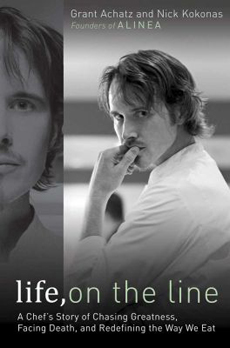BOOK REVIEW: Life, On The Line
 Life, On The Line, has a double meaning. Photo courtesy Gotham Books. |
Uber-foodies know the name Grant Achatz (pronounced AK-its), the wunderkind chef whose brilliant career, laden with the top honors and awards,* almost came to a tragic end. In 2007, the year after his Chicago restaurant, Alinea, was named the best in the country by Gourmet magazine, Achatz was diagnosed with Stage IV squamous cell carcinoma cancer of the tongue (there is no Stage V). The protocol to save his life was to remove his tongue and part of his jaw, which would have ended his ability to taste and to speak. He was 33 years old, one of the world’s great young chefs. Fortunately for Achatz and his many friends and fans, his business partner, Nick Kokonas, found a clinical trial at the University of Chicago, which used chemotherapy and radiation instead of surgery. Treatment was gruesome but successful; the chef’s sense of taste, obliterated by the treatment, ultimately returned. The food-loving universe sends a million thanks to Kokonas and the doctors involved. In October 2008, Achatz and Kokonas published Alinea, a hardcover coffee table book featuring more than 100 of the restaurant’s recipes (exquisite, but not for the beginner!). |
|
|
In March 2011, the team’s second book, Life, on the Line: A Chef’s Story of Chasing Greatness, Facing Death, and Redefining the Way We Eat, was published. It is now available in paperback and Kindle editions. Life, On The Line We received a review copy earlier this year, but it got fused into a pile of books waiting to be read (the pile is 44 inches high). Finally, with a rare day of free time (Independence Day, like most national holidays, is one of our book catch up days), we cracked it. We started reading in the morning, headed to a friend’s house, plopped onto a chaise longue and breezed through all 390 pages before we went to sleep—taking an hour or so to watch the fireworks and interact with other house guests. Beautifully written (the voices of Achatz and Kokonas are virtually identical, leading us to guess that a professional writer iced the cake, as it were), we eagerly devoured chapter after chapter. *Food & Wine’s “Best New Chefs,” 2002; James Beard Foundation”s “Rising Star Chef Of The Year,” 2003; Gourmet magazine’s “Best Restaurant in America,” 2006; James Beard Foundation’s “Outstanding Chef,” 2007; Restaurant magazine’s “#1 Restaurant in North America” and “#7 Restaurant In The Word,” 2010. |
||
|
Life, On The Line has a double meaning, detailing Achatz’s life as a chef on the kitchen line and his almost miraculous survival, when the cancer put his life on the line. Like many top chefs, he has a passion, energy and work ethic that seem almost unbelievable. There are many people who work ridiculously long hours, but few of those jobs require the combination of constant creativity, staff supervision and training, and pressure to produce perfection for five or six hours at the end of a long day—not to mention standing on your feet in a hot kitchen.
Young Grant, who grew up in the small town of St. Clair, Michigan, began his culinary career peeling vegetables and cracking eggs in his grandmother’s café—a family affair that included his mother and aunts. He notes, “I never got an Easy Bake oven or a play kitchen. I played every day at the Achatz Café….” His parents then started their own successful restaurant, and by high school he had assumed weekly shifts at Achatz Depot—alongside his parents, uncles and cousins. |
 Grant Achatz receiving a 2009 James Beard Award, one of several different Beard Awards, for his Alinea cookbook. Photo courtesy James Beard Foundation. |
|
|
From Student To Star After high school, Achatz headed to the prestigious Culinary Institute of America. He began a restaurant externship at Grand Rapids’ finest restaurant, starting at the lowest level: peeling vegetables and prepping ingredients for the meals, making soups and salad dressings. In a mere month, he was moved to the roast/grill station on the hot line—a fast-track promotion for the 19-year-old culinary student. To fast-forward: Achatz then began as a commis, or prep cook (from the French word for assistant), at the celebrated French Laundry in Napa Valley. (Do you know the different positions in a professional kitchen? French Laundry was then regarded as the best restaurant in America (and remains a contender for top honors, depending on who’s creating the list). Achatz rose to sous-chef under mentor Thomas Keller before taking over the kitchen at Trio, outside of Chicago. One of his best customers was Nick Kokonas, who three years later bankrolled his next move: chef/co-owner of Alinea. Far more than serving as financier, Kokonas became the all-around business partner most entrepreneurs can only hope for. The heart and soul of the book is Achatz’s journey from culinary school to top of the world at a very young age. No prima donna, he is Everychef. His path was similar to that of many gifted chefs, most of whom work fourteen hour, backbreaking days to create beautiful cuisine. Not every chef wins the accolades Achatz has and/or ends up owning a renowned restaurant, but most of them merit an A for effort. If you enjoy a great restaurant meal, Life, On The Line will give you a far greater appreciation of it. Once Achatz and Kokonas begin to discuss a partnership, Achatz’s chapters alternate with those penned by Kokonas, who provides a perspective on restaurant development and management (not easy—another reason to more deeply appreciate that delicious meal). The book comprises behind-the-scenes insights—general management and front of the house views from Kokonas, back of the house perspectives from Achatz. It’s a serious book, with one amusing section early on (amusing to us, frustrating to Chef Achatz): The young culinary school graduate decides to leave his unhappy job at Charlie Trotter’s after eight weeks (read the Chapter 5 and you’ll see that writing well is the best revenge). Using his savings (“There aren’t a whole lot of ways to spend money in St. Clair or Grand Rapids….”), he embarks on what he believes will be an inspirational three-star restaurant tour of Europe, booking dinners at Les Crayères (average meal, condescending service), Georges Blanc (grey, overcooked squab and indifferent/insulting response from the chef and maitre ‘d) and Enoteca Pincchiori in Florence (good but not celestial). His best meal was at an unnamed family restaurant with superb home cooking, that happened to be on a bike route he took. He returned to the U.S. and found his inspiration in California, with Chef Thomas Keller at The French Laundry. To get the tryout, he wrote a letter a day for fourteen days, telling Chef Keller why he wanted the job. The rest is culinary history. If you’ve never had Achatz’s food, by the middle of the book you’ll feel as if you had. It’s a delicious gastronomic experience. Alinea: A New Train Of Thought Alinea is an editor’s mark denoting the beginning of a new train of thought, exemplified by a new paragraph. It is more commonly known as the paragraph mark, less commonly as the pilcrow. The literal translation from Latin, a linea, means “off the line.” There’s a double meaning: Alinea represents a new train of thought about food, and as a restaurant, the food comes “off the line.” The line is the section of the kitchen where the food is cooked. You have to know, or know of, Achatz’s food to be in love with this book. Then, you can see, smell and taste every dish he describes. We were fortunate enough to dine twice at Trio during his tenure, and then at Alinea. We love the total experience he creates: innovative, intellectual, breathtaking and exquisitely delicious food, presented in new ways, down to the custom-made serving pieces designed to showcase a particular dish. Why serve a slice of seared foie gras with rhubarb purée, when you can purée the foie gras, mold it into a thin, hollow cylinder and fill it with rhubarb foam? The presentation comprises small tastes of many different courses (maybe 18, maybe 40), that push the envelope and create a memorable evening. Molecular Gastronomy We are cautioned by Kokonas not to refer to the cuisine as molecular gastronomy, which is perceived of by some of its finest practitioners as having overtones of gimickry and mad-scientist cooking. The U.K.’s Heston Blumenthal dislikes the term, believing it makes the cuisine sound “complicated” (it is!) and “elitist” (it is!). Ferran Adrià, the Catalan chef, has referred to his cooking as deconstructivist (not exactly tasty-sounding!). Deconstruction is a method in which the elements of a classic dish appear in a different shape or form.† Hervé This, the “father of molecular gastronomy,” reintroduced the concept in 2004 as “culinary constructivism.” According to Blumenthal, whose restaurant, The Fat Duck, has been named the best restaurant in the world more than once (for the past three years, the honor has gone to Noma in Copenhagen, helmed by chef/co-owner, René Redzepi, an El Bulli alumnus): “The fashionable term ‘molecular gastronomy’ was introduced relatively recently, in 1992, to name a particular academic workshop for scientists and chefs on the basic food chemistry of traditional dishes. That workshop did not influence our approach, and the term ‘molecular gastronomy’ does not describe our cooking, or indeed any style of cooking…. “We may use modern thickeners, sugar substitutes, enzymes, liquid nitrogen, sous-vide, dehydration, and other nontraditional means, but these do not define our cooking. They are a few of the many tools that we are fortunate to have available as we strive to make delicious and stimulating dishes” (see the entire statement). Some chefs prefer the term “culinary physics” and “experimental cuisine.” Anything is fine with us: Just tell us what it is! Otherwise, we nominate “innovation cuisine,” given that this decade’s innovation can become the next decade’s mainstream. To decide for yourself, check out some of the techniques here. There are emulification, fragrant foams, vapors, gelification, spherification, reverse spherification, other reshaped liquids, fatty liquids transformed into powders and other concepts from food science. Here’s a history of molecular gastronomy. You can also pick up a copy of Hervé This’s book, Molecular Gastronomy: Exploring the Science of Flavor. As Kokonas wrote in an online article: “A trip to El Bulli restaurant in Roses, Spain under the direction of chef Ferran Adrià let Grant know that you could take classical technique, apply equal measures of whimsy, intelligence, creativity and technology, and transform the dining experience.” Some of Achatz’s dishes (from Trio and Alinea): If you’re inspired by this menu, book a trip to Alinea. It’s not an easy reservation to get, but the book tells us that January is the slow month. January is not Chicago’s kindest month, but the experience will be worth it. Try to rea the book first. †In a simple example, think of Eggplant Parmesan, deconstructed. Instead of the fried eggplant slices baked with mozzarella and tomato sauce, the eggplant is sautéed in olive oil and topped with ricotta and sauce. Instead of breaded slices, bread crumbs are used as a garnish.
|
||